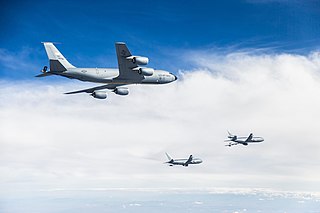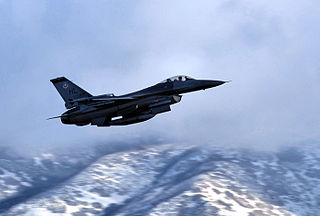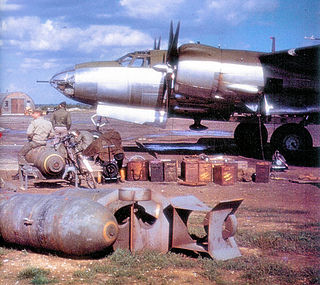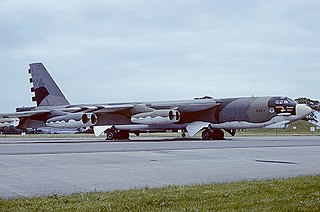
The 370th Flight Test Squadron is an active United States Air Force unit assigned to the 413th Flight Test Group, stationed at Edwards Air Force Base, California. It has been active in the flight test role since 2001.

The 497th Air Expeditionary Group is a provisional United States Air Force unit. It is assigned to Pacific Air Forces to activate or inactivate as needed.

The 494th Air Expeditionary Group is a provisional United States Air Force group assigned to Air Mobility Command (AMC) to activate or inactivate as needed. The group was activated in the events surrounding Operation Iraqi Freedom, the 2003 United States invasion of Iraq. Now-Lieutenant General Stayce D. Harris is listed by the USAF as commanding the 494th AEG at Moron Air Base, Spain, from July to October 2003. In addition, a patch published at USAF Patches.com implies that the group was active in Spain during "Iraqi Freedom."

The 188th Rescue Squadron is unit of the New Mexico Air National Guard. It is assigned to the 150th Special Operations Wing located at Kirtland Air Force Base, New Mexico.

The 418th Test and Evaluation Squadron is an active United States Air Force unit assigned to the 53rd Test and Evaluation Group, and stationed at Davis-Monthan Air Force Base, Arizona, where it was activated on 1 October 2021.

The 384th Air Refueling Squadron is an active United States Air Force unit, stationed at Fairchild Air Force Base, Washington, where it is assigned to the 92d Operations Group and operates the Boeing KC-135 Stratotanker aircraft conducting air refueling missions.

The 419th Flight Test Squadron is a United States Air Force squadron. It is assigned to the 412th Operations Group, Air Force Materiel Command, stationed at Edwards Air Force Base, California.

The 514th Flight Test Squadron is a squadron of the United States Air Force, which has been stationed at Hill Air Force Base, Utah since 1973, performing functional flight checks on aircraft undergoing major maintenance.

The 53rd Weapons Evaluation Group is a United States Air Force unit that reports to the 53rd Wing. It is stationed at Tyndall Air Force Base, Florida. The unit is part of Air Combat Command.

The 44th Fighter Group is an Air Reserve Component (ARC) unit of the United States Air Force. It is assigned to the Tenth Air Force, Air Force Reserve Command (AFRC), stationed at Tyndall Air Force Base, Florida. The 44 FG is an associate unit of the active duty 325th Fighter Wing of the Air Combat Command (ACC). If mobilized to active duty, the 44 FG is operationally gained by ACC. Otherwise, the 44 FG operates as a geographically separated unit (GSU) of AFRC's 301st Fighter Wing at NAS JRB Fort Worth, Texas.

The 515th Bombardment Squadron is an inactive United States Air Force unit. It was first formed in the Middle East in 1942 to reinforce the Royal Air Force in North Africa with personnel and aircraft diverted from delivery to the China Burma India Theater. The squadron moved forward, eventually being stationed in Italy, where it participated in the strategic bombing campaign against Germany, and was awarded three Distinguished Unit Citations for its combat actions. Following V-E Day, the squadron returned to the United States, where it converted to Boeing B-29 Superfortress bombers, but was inactivated in March 1946.

The 585th Bombardment Squadron is an inactive United States Air Force unit that was assigned to the 394th Bombardment Group. It was a Martin B-26 Marauder unit that was organized and trained in the United States during World War II. It flew combat missions in the European Theater of Operations, where it earned a Distinguished Unit Citation and a French Croix de Guerre with Palm. After V-E Day, it served with the occupation forces in Germany until returning to the United States and inactivating at Bolling Field, District of Columbia on 31 March 1946.

The 587th Bombardment Squadron is an inactive United States Air Force unit that was assigned to the 394th Bombardment Group. It was a Martin B-26 Marauder unit that was organized and trained in the United States during World War II. It flew combat missions in the European Theater of Operations, where it earned a Distinguished Unit Citation and a French Croix de Guerre with Palm. After V-E Day, it served with the occupation forces in Germany until inactivating on 28 December 1945 as the 394th Group converted to Douglas A-26 Invaders.

The 494th Bombardment Squadron is an inactive United States Air Force unit, assigned to the 344th Bombardment Group, The squadron was activated in September 1942, and until July 1943 served as a Replacement Training Unit. It then began training for combat operations, deploying to the European Theater of Operations in January 1944. It participated in combat, earning a Distinguished Unit Citation for air support of ground troops during Operation Cobra. After V-E Day, the squadron became part of the occupation forces until it was inactivated on 31 March 1946.

The 644th Bomb Squadron is an inactive United States Air Force unit. It was last assigned to the 410th Bombardment Wing at K. I. Sawyer Air Force Base, Michigan, where it was inactivated on 21 November 1994.

The 668th Bomb Squadron is an inactive United States Air Force unit. It was last assigned to the 416th Operations Group at Griffiss Air Force Base, New York, where it was inactivated on 1 January 1995.

The 671st Bombardment Squadron is a former United States Army Air Forces unit, assigned to the 416th Bombardment Group. The squadron was activated a medium bomber unit during World War II. It trained in the United States before deploying to the European Theater of Operations, where it served with Ninth Air Force. It moved to the continent of Europe following D-Day and continued operations until the end of the war, earning a Distinguished Unit Citation for its actions in combat. It returned to the United States in the fall of 1945 and was inactivated at the port of embarkation.

The 670th Bombardment Squadron is a former United States Army Air Forces unit, assigned to the 416th Bombardment Group. The squadron was activated a medium bomber unit during World War II. It trained in the United States before deploying to the European Theater of Operations, where it served with Ninth Air Force. It moved to the continent of Europe following D-Day and continued operations until the end of the war, earning a Distinguished Unit Citation for its actions in combat. It returned to the United States in the fall of 1945 and was inactivated at the port of embarkation.

The 597th Bombardment Squadron is an inactive United States Air Force unit. It was activated at MacDill Field, Florida in April 1943. After training in the United States, it transferred to the European Theater of Operations, where it was a component of IX Bomber Command. The squadron served in combat from April 1944 until the end of World War II, earning a Distinguished Unit Citation for an attack on Ediger-Eller, Germany, in December 1944 during the Battle of the Bulge. Following V-E Day the squadron remained in France until December 1945, when it returned to the United States and was inactivated at Camp Shanks in January 1946.

The 323d Expeditionary Operations Group is a provisional United States Air Force unit assigned to the United States Air Forces in Europe. As a provisional unit, it may be activated or inactivated at any time.




























